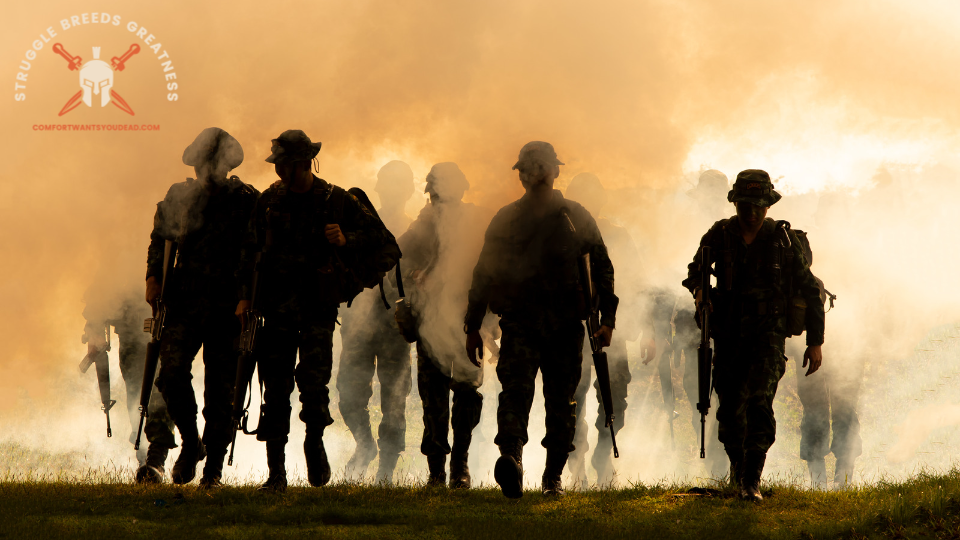The United States Army Special Forces, also known as the Green Berets, require candidates to undergo an extensive selection and training process to ensure they possess the physical and mental capabilities needed for their demanding roles. While I can provide some general guidelines, it’s important to note that specific training programs may vary, and it’s always recommended to consult with a qualified trainer or seek guidance from a military recruiter for the most accurate and up-to-date Army Special Forces training program.

Here are some key elements to include in any workout for an Army Special Forces Training Program:
- Cardiovascular Endurance: Develop a high level of cardiovascular fitness to meet the demands of long-duration, high-intensity activities. Include exercises such as running, swimming, rucking (marching with a weighted backpack), and high-intensity interval training (HIIT).
- Strength and Power: Focus on building functional strength and power through exercises like weightlifting, bodyweight exercises (push-ups, pull-ups, squats), kettlebell workouts, and explosive movements (box jumps, medicine ball throws). Emphasize compound exercises that engage multiple muscle groups simultaneously.
- Core Stability: Strengthen your core muscles (abdominals, lower back, and hips) to enhance overall stability and prevent injuries. Incorporate exercises such as planks, Russian twists, hanging leg raises, and medicine ball slams.
- Flexibility and Mobility: Maintain good flexibility and mobility to enhance performance and reduce the risk of injuries. Incorporate dynamic stretching, yoga, and mobility exercises into your routine.
- Endurance Training: Develop the ability to perform under prolonged physical stress. Incorporate long-distance running, hiking with weighted packs, and other endurance-based activities to build mental and physical stamina.
- Tactical Skills: Depending on your stage in the training process, consider integrating skills specific to Special Forces operations. This may include practicing land navigation, obstacle courses, buddy carries, rappelling, and other tactical exercises.
Remember, consistency and gradual progression are key to achieving your goals while avoiding overtraining or injuries. Additionally, ensure you maintain a balanced diet and prioritize sufficient rest and recovery to support your training efforts.
It’s important to note that the Army Special Forces training program is highly specialized and rigorous. If you are serious about pursuing this path, consider contacting a military recruiter or seeking guidance from individuals with experience in the Special Forces to receive personalized recommendations and training plans tailored to the specific requirements and standards of the program.
Here’s an example of a 60-day workout program for an aspiring Army Special Forces candidate. This program incorporates a variety of exercises and training modalities to address the key aspects mentioned earlier. Remember to warm up before each workout and cool down/stretch afterward. Adjust the intensity and weights based on your fitness level and consult with a qualified trainer if needed.
Note: This is a sample program and should be adapted to your specific needs and abilities.

Phase 1: Foundation Building (Days 1-15)
Day 1:
- Morning: 30-minute run at a moderate pace
- Afternoon: Strength training
- Squats: 3 sets of 10 reps
- Push-ups: 3 sets of 10 reps
- Pull-ups or assisted pull-ups: 3 sets of 8 reps
- Planks: 3 sets of 30 seconds
Day 2:
- Morning: Swimming for 30 minutes (focus on technique and endurance)
- Afternoon: Cardiovascular endurance
- 1-mile run for time
Day 3:
- Morning: Rucking
- Start with a 20-minute ruck with a lightweight backpack (around 10% of your body weight) and gradually increase the duration and weight over time.
- Afternoon: Core workout
- Russian twists: 3 sets of 20 reps
- Hanging leg raises: 3 sets of 10 reps
- Plank variations: Front plank, side planks (each for 30 seconds)
Repeat this 3-day cycle for the first two weeks, gradually increasing the intensity, duration, or weights as you progress.
Phase 2: Strength and Power Development (Days 16-30)
Day 16:
- Morning: 40-minute run at a moderate pace
- Afternoon: Strength training
- Deadlifts: 4 sets of 8 reps
- Overhead press: 4 sets of 8 reps
- Dips: 4 sets of 10 reps
- Medicine ball slams: 4 sets of 10 reps
Day 17:
- Morning: Swim intervals
- 10 x 50-meter sprints with 30 seconds rest between each
Day 18:
- Morning: Rucking
- 30-minute ruck with a moderately weighted backpack (around 20% of your body weight)
- Afternoon: Core workout
- Plank with leg lifts: 3 sets of 12 reps (each leg)
- Bicycle crunches: 3 sets of 20 reps
- Russian twists with medicine ball: 3 sets of 15 reps
Continue the 3-day cycle, gradually increasing intensity and weights as you progress.
Phase 3: Endurance and Tactical Skills (Days 31-45)
Day 31:
- Morning: 45-minute run at a steady pace
- Afternoon: Endurance workout
- Ruck for 60 minutes with a weighted backpack (around 30% of your body weight)
Day 32:
- Morning: Swim intervals
- 10 x 100-meter sprints with 30 seconds rest between each
Day 33:
- Morning: Obstacle course training
- Practice various obstacle course challenges, focusing on speed and efficiency
Continue the 3-day cycle, gradually increasing the duration and difficulty of the endurance and tactical skill workouts.
Phase 4: Intensity and Conditioning (Days 46-60)
Day 46:
- Morning: 60-minute run, alternating between moderate and high-intensity intervals
- Afternoon: High-intensity interval training (HIIT)
- Burpees: 5 sets of 15 reps
- Box jumps: 5 sets of 10 reps
- Kettlebell swings: 5 sets of 12 reps
Day 47:
- Morning: Swim intervals
- 10 x 200-meter sprints with 30 seconds rest between each
Day 48:
- Morning: Rucking
- 90-minute ruck with a heavily weighted backpack (around 40% of your body weight)
Continue the 3-day cycle, gradually increasing the intensity and volume of the workouts.
Remember to periodically reassess your progress, modify the program as needed, and prioritize rest and recovery to avoid overtraining.
Please note that this is just a sample Army Special Forces training program, and it’s important to consult with a professional trainer or seek guidance from military professionals to create a personalized plan that suits your specific goals, abilities, and any individual requirements.





